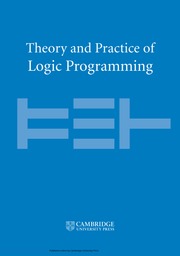Article contents
Top-down and Bottom-up Evaluation Procedurally Integrated
Published online by Cambridge University Press: 10 August 2018
Abstract
This paper describes how the Logic Programming System XSB combines top-down and bottom-up computation through the mechanisms of variant tabling and subsumptive tabling with abstraction, respectively.
It is well known that top-down evaluation of logical rules in Prolog has a procedural interpretation as recursive procedure invocation (Kowalski 1986). Tabling adds the intuition of short-circuiting redundant computations (Warren 1992). This paper shows how to introduce into tabled logic program evaluation a bottom-up component, whose procedural intuition is the initialization of a data structure, in which a relation is initially computed and filled, on first demand, and then used throughout the remainder of a larger computation for efficient lookup. This allows many Prolog programs to be expressed fully declaratively, programs which formerly required procedural features, such as assert, to be made efficient.
- Type
- Original Article
- Information
- Theory and Practice of Logic Programming , Volume 18 , Special Issue 3-4: 34th International Conference on Logic Programming , July 2018 , pp. 706 - 721
- Copyright
- Copyright © Cambridge University Press 2018
References
- 1
- Cited by


